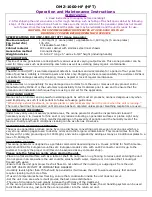
7
7. Maintenance
7.1.
Gas charge (Fig. 7-1)
1. Connect gas cylinder to the service port of stop valve (3-way).
2. Execute air purge of the pipe (or hose) coming from refrigerant gas cylinder.
3. Replenish specified amount of refrigerant, while running the air conditioner
for cooling.
Note:
In case of adding refrigerant, comply with the quantity specified for the refrig-
erating cycle.
Caution:
• Do not discharge the refrigerant into the atmosphere.
Take care not to discharge refrigerant into the atmosphere during installa-
tion, reinstallation, or repairs to the refrigerant circuit.
• For additional charging, charge the refrigerant from liquid phase of the gas
cylinder.
If the refrigerant is charged from the gas phase, composition change may
occur in the refrigerant inside the cylinder and the outdoor unit. In this case,
ability of the refrigerating cycle decreases or normal operation can be impos-
sible. However, charging the liquid refrigerant all at once may cause the com-
pressor to be locked. Thus, charge the refrigerant slowly.
To maintain the high pressure of the gas cylinder, warm the gas cylinder with warm
water (under 40°C) during cold season. But never use naked fire or steam.
B
A
G
H
K
L
M
I
J
C
D
E
F
A
Indoor unit
B
Union
C
Liquid pipe
D
Gas pipe
E
Stop valve
F
Outdoor unit
G
Refrigerant gas cylinder operating valve
H
Refrigerant gas cylinder for R410A with
siphon
I
Refrigerant (liquid)
J
Electronic scale for refrigerant charging
K
Charge hose (for R410A)
L
Gauge manifold valve (for R410A)
M
Service port
Fig. 7-1
S1
S2
S3
S1
S2
S3
Warning:
There is high voltage potential on the S3 terminal caused by electrical circuit design that has no electrical insulation between power line and communication
signal line. Therefore, please turn off the main power supply when servicing. And do not touch the S1, S2, S3 terminals when the power is energized. If isolator
should be used between indoor unit and outdoor unit, please use 3-poles type.
230V
Single phase
Isolator
3 poles isolator
Outdoor
Unit
Indoor
Unit
6. Electrical work
Outdoor unit model
Outdoor unit power supply
Outdoor unit input capacity
*1
Main switch (Breaker)
Outdoor unit power supply
Outdoor unit power supply earth
Indoor unit-Outdoor unit
Indoor unit-Outdoor unit earth
Outdoor unit L-N
*2
Indoor unit-Outdoor unit S1-S2
*2
Indoor unit-Outdoor unit S2-S3
*2
Wir
ing
Wire No
.
×
size (mm
2
)
Circuit
rating
SUZ-KA25/KA35
SUZ-KA50/KA60/KA71
~/N (single), 50 Hz,
~/N (single), 50 Hz,
230 V
230 V
10 A
20 A
2
×
Min. 1.5
2
×
Min. 2.5
1
×
Min. 1.5
1
×
Min. 2.5
3
×
1.5 (Polar)
3
×
1.5 (Polar)
1
×
Min. 1.5
1
×
Min. 1.5
AC 230 V
AC 230 V
AC 230 V
AC 230 V
DC 12 V ~ DC 24 V
DC 12 V ~ DC 24 V
*1. A breaker with at least 3 mm contact separation in each poles shall be provided. Use non-fuse breaker (NF) or earth leakage breaker (NV).
*2. The figures are NOT always against the ground.
S3 terminal has DC 24 V against S2 terminal. However between S3 and S1, these terminals are NOT electrically insulated by the transformer or other device.
Notes: 1. Wiring size must comply with the applicable local and national code.
2. Power supply cords and Indoor/Outdoor unit connecting cords shall not be lighter than polychloroprene sheathed flexible cord. (Design 60245 IEC 57)
3. Install an earth longer than other cables.
6.2. Field electrical wiring


























